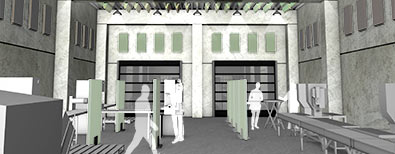A
11 Beiträge in dieser Lexikon KategorieA-Weighting db(A)
A-weighting is the adaptation of objective sound level measurements (unit: dB) to a normal person's subjective sound sensation (unit: dB(A)) on the basis of an internationally standardized frequency weighting curve A. A-weighted values reflect more closely the actual (frequency-dependent) response of the human ear to a specific sound event. Most measurement devices already use A-weighting, but if this is not the case, A-weighting can be applied later using standard values.
Absorber
Acoustic absorbers are materials that absorb solid-borne resp. air-borne sound. For the absorption of air-borne sound, open-cell foams or fibrous materials such as polyester non-wovens are used, while solid-borne sound absorption relies on absorber layers, e.g. heavy foils, that dampen the vibrations of a solid body.
Absorption
Absorption is the reduction ("attenuation") of the sound level through conversion of the sound energy to another form of energy, primarily heat (dissipation).
Absorption coefficient
Absorption coefficient α is a measure of the effectivity of absorber materials. It indicates the proportion of sound waves that are absorbed. For example, α = 0.5 means that half of the sound energy is absorbed. α = 0 means that the sound waves are not absorbed at all, but completely reflected. α = 1 means that the sound is absorbed in its entirety.
Acoustics
Acoustics is the science of sound: It investigates its generation, propagation, transmission, perception and effects. In any case, the acoustic conditions in a given space greatly affect the wellbeing of the people staying there.
Air absorption
Sound waves propagating through the air over large distances are partially absorbed by the air, depending on temperature and humidity conditions. Part of the sound waves’ energy is transformed into frictional or thermal energy.
Air-borne sound
Air-borne sound is defined as the propagation of sound waves through the air. Air-borne sound propagates only in the form of longitudinal waves.
Air-borne sound attenuation
Air-borne sound attenuation is the weakening of an air-borne sound event by means of sound-absorbing materials. Most effective for this purpose are absorber materials that present a large surface area with open pores through which the sound waves can enter. The resulting oscillation of the air molecules inside the pores converts the sound energy into heat due to friction losses at the pore walls.
Air-borne sound insulation
Air-borne sound insulation impedes the transmission of air-borne sound to adjacent areas. This can be achieved for ex. through the encapsulation of the sound source or the construction of noise insulation walls. Effective insulation requires heavy and preferably flexible acoustic materials.
Anechoic chamber/acoustically dead room
An anechoic chamber is an acoustic laboratory the inner surfaces of which are covered with sound absorption materials in order to (almost) completely eliminate the reflection of sound waves.
Attenuation/Damping
(Sound) attenuation or dampening is the decrease in the level of air-borne sound through absorption: A certain proportion of the sound waves is transformed into heat energy and thus “lost”.





